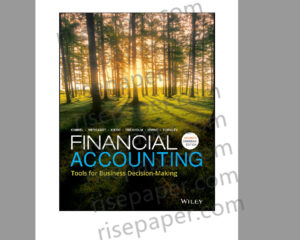
留学顾问の QQ:2128789860
留学顾问の微信:risepaper
上图的书是Financial Accounting: Tools for Business Decision-Making, Seventh Canadian Edition
BRIEF CONTENTS
1 The Purpose and Use of Financial Statements代写
2 A Further Look at Financial Statements
3 The Accounting Information System
4 Accrual Accounting Concepts
5 Merchandising Operations
6 Reporting and Analyzing Inventory代写
7 Internal Control and Cash
8 Reporting and Analyzing Receivables
9 Reporting and Analyzing Long-Lived Assets代写
10 Reporting and Analyzing Liabilities
11 Reporting and Analyzing Shareholders’ Equity代写
12 Reporting and Analyzing Investments
13 Statement of Cash Flows
14 Performance Measurement代写
没有别的好办法,本门课想要好成绩的话,就照着test bank使劲就是了!
For each of the following financial statement users, indicate whether they
would be an “internal” or “external” user:
(a) Bank (lender)
(b) Shareholders
(c) Employees (non-management)
(d) Suppliers
(e) Labour union
(f) Canada Revenue Agency
(g) Management
Profitability Analysis
Selected information from the financial statements of two companies
competing in the same industry follows:
De Marchi
Corporation
Bear
Limited
Total assets, beginning of year $388,000 $372,000
Total assets, end of year 434,000 536,000
Total liabilities, beginning of year 119,000 76,000
Total liabilities, end of year 97,000 135,000
Total common shareholders’ equity,
beginning of year
269,000 296,000
Total common shareholders’ equity, end
of year
337,000 401,000
Net sales 660,000 780,000
Gross profit 175,000 248,000
Net income 68,000 105,000
(a) For each company, calculate the following ratios: debt to total assets, gross profit margin, profit margin, asset turnover, return on assets, and return on common shareholders’ equity.
(b) Which company is more profitable? Explain.
(c) What is the key driver of Bear Limited’s return on common shareholders’ equity ratio—return on assets or debt to total assets—when compared with that of De Marchi Corporation? Explain.
